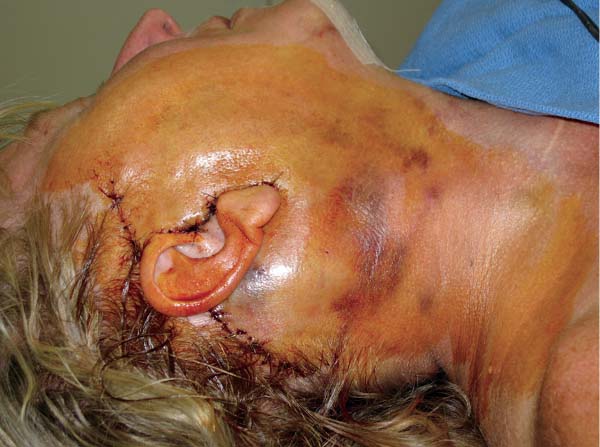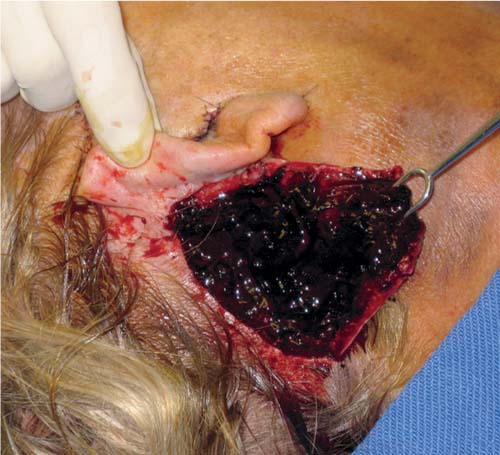11 The effort to rejuvenate the aging neck and face can have intermediate consequences before the desired end result is achieved. These consequences, as described by Truswell,1 can be either unavoidable side effects of surgery, such as bruising or swelling, or can take the form of incisional scarring and complications. In contrast to sequelae, which are usually expected with aesthetic surgery of the head and neck, complications of such surgery are not inevitable. It is important that the aesthetic surgeon distinguish the various types of sequelae and side effects of surgery from the less frequent complications that may occur. Complications can result from poor surgical planning or poor surgical execution, or more commonly, from undetermined circumstances that are difficult to predict. We will discuss the complications after aesthetic surgery for rejuvenation of the neck. Postoperative fluid collections, most commonly in the form of hematomas from bleeding or the oozing of blood, can be seen in as many as 15% of patients undergoing face/necklift surgery.2 In properly performed cosmetic surgery of the neck, small pockets of serous fluid and blood can infiltrate the dermis, subcutaneous plane, and underlying muscle structure, resulting in the perception of “lumps and bumps.” These small collections of fluid are normal in the initial postoperative period, and by definition cannot be aspirated. Supportive garments, massage, and time will allow their complete resolution. These small collections of fluid differ from a localized collection of blood, which is defined as a hematoma. If detected at an early point, within hours after surgery, a hematoma can be evacuated before causing the separation of skin flaps in the neck from the underlying muscle structure. This can be accomplished by needle aspiration if minimal incisions were used, or more commonly by opening the postauricular or submental incision, placing or replacing subcutaneous drains, and applying a pressure dressing. If a longer period passes before the treatment of a hematoma, the subcutaneous blood will have coagulated and cannot be aspirated. Immediate treatment is necessary for larger hematomas or those that are actively bleeding or expanding (Fig. 11.1), because the separated skin flap in such cases is exposed to the acidic effects of degenerating blood products that put the flap at risk of necrosis and permanent tissue loss. This can be done by reopening the postauricular or submental incision (Fig. 11.2), and can be accomplished in an office-based or ambulatory surgical facility. Patients may have to stay overnight for observation during the 12 hours after treatment. If the hematoma is relatively small, it can usually be successfully treated with observation and repeated needle aspiration, although aspiration usually cannot be accomplished until the hematoma begins to liquefy, which typically occurs on postoperative days 8 to 12. Delayed healing and hyperpigmentation are among other possible complications of rejuvenation surgery of the head or neck. A seroma exists when localized fluid is present in the subcutaneous plane. Often the result of an untreated hematoma, a seroma can also separate a skin flap from the underlying muscle and cause irregularities in contour, such as skin rippling. As in the case of a hematoma, repeated aspiration is the preferred treatment for a seroma. In cases of significant flap separation, a pressure dressing must be applied to avoid the recurrence of a seroma and propagation of the cycle of fluid accumulation, flap separation, and regeneration of seromas. An infection can result from any surgical procedure but is uncommon in facial procedures because of the copious blood supply of the face and neck. Some treatments of the neck, and specifically contouring of fat, will make infections more likely than would the same treatments in adjacent areas. Necks that require significant fat contouring are more likely to become infected because of inadequate evacuation of denuded fat cells and blood. The fat cells die and mix with blood to become an ideal medium for bacterial growth. Infections of this type usually manifest at about a week postoperatively and present early in the form of isolated painful swelling of the neck. Within days the infected area becomes erythematous and fluctuant as swelling and pain increase. In most cases organisms such as Streptoccocus or Staphylococcus are the causative agents of such infections, and specific antibiotic coverage for these organisms should be provided. Because organisms on the skin are the usual pathogens in such infections, and most nonpenicillin or cephalosporin antibiotics provide only limited coverage of the spectrum of organisms on the skin, cervical infections of the type described here are more common in penicillin-allergic patients. Fig. 11.1 Presentation of expanding hematoma 24 hours postoperatively. (From Truswell WH, ed. Surgical Facial Rejuvenation: A Roadmap to Safe and Reliable Outcomes. New York, NY: Thieme Medical Publishers; 2009:37, Figure 3.17. Reprinted by permission.) Prompt attention is necessary both to treating cervical infections of the type described above and preventing soft-tissue damage from them. Local treatment is also necessary and includes warm compresses and repeated needle aspirations. Because these infections behave like abscesses, their abscess-like acidic environment can cause soft-tissue necrosis, especially of surrounding subcutaneous fat. This can produce a permanent contour defect from the asymmetric loss of fat. Immediate culture of fluid aspirated from such an infection can improve the efficacy of their antibiotic coverage. If the infection is proximal to a submental or postauricular incision, evacuation can be done through these incisions. If the incision is not proximal and frequent follow-up care is needed, localized aspiration can be used to treat the infection without disturbing an incision that is healing well. Fig. 11.2 Exposure of hematoma prior to evacuation. (From Truswell WH, ed. Surgical Facial Rejuvenation: A Roadmap to Safe and Reliable Outcomes. New York, NY: Thieme Medical Publishers; 2009:37, Figure 3.18. Reprinted by permission.) The occurrence of sialoma or salivary drainage from the submandibular gland is very unusual in most uncomplicated surgical procedures on the neck. Procedures associated with partial excision of a submandibular gland can be complicated by sialoma, but this is again very infrequent. A parotid fistula can lead to the accumulation of saliva in the neck in patients undergoing rhytidectomy, but this complication too is rare. An accumulation of fluid that does not respond to simple treatment methods should be suspected as possibly being a sialoma. Current treatment of these lesions now includes Botox to block the innervation of the affected gland. Because cosmetic surgery of the neck usually requires the separation of skin of the neck from the underlying platysma muscle, the resultant skin flap can be vulnerable to ischemic complications. The incidence of skin necrosis in cervical and facial surgery is reported to range from 3 to 5%, with the most frequently involved areas being those of a postauricular incision and flap, followed by sites of flap closure adjacent to the superior auricle and hair tuft, and of flaps adjacent to the lobule of the ear. When an area of skin on the neck becomes ischemic, it can break down, with ensuing tissue loss and permanent visible scarring. Etiologies of skin breakdown vary, and most commonly include overaggressive liposuction of the fat of a raised skin flap or aggressive cautery of bleeding vessels on the undersurface of a skin flap. In these situations the skin breakdown can be delayed and show only the minimal initial sign of sloughed epithelium as an indicator of trans-mural ischemic skin injury. The injury and tissue loss in such cases are usually small, but can be cosmetically obvious, and because of the ischemia are slow to heal. Denuding the ischemic edges of such a site and suturing the healthy tissue edges can expedite the healing process. Other causes of skin injury and tissue loss are untreated hematomas or infections, and distressed healing in cigarette smokers (Fig. 11.3). In these situations the acidic components of both a hematoma and the infectious process, together with skin-flap separation, can create soft-tissue ischemia and, especially if left untreated, lead to necrosis of a skin flap. Cigarette smoking and a history of past cigarette smoking are probably the single greatest factors predisposing to skin necrosis after surgery of the neck and face, with the risk of flap necrosis for smokers who continue to smoke up to the time of their surgery and postoperatively being 12.5 times that for nonsmokers.2 Diabetic patients are also at risk of problematic healing after surgery of the face and neck, but not to the same extent as cigarette smokers. Tight compression dressings can contribute to vascular compromise in a flap, and the need for such dressings should address their potential threat to wound healing. In patients with delayed healing or skin necrosis of a flap, the underlying causative process should be permitted to resolve completely so that secondary repair of the flap can proceed if necessary. Some areas will heal satisfactorily without secondary intervention. Treatment consists of conservative wound care and debridement, followed by laser treatment or scar revision of any full-thickness wounds after the eschar has resolved. The introduction of fractional ablative lasers has been useful for blending some epidermal irregularities into the skin contour in patients with delayed healing or skin necrosis, and is also helpful for irregular surgical scars. Fig. 11.3 Necrosis behind the ear of a smoker at 2 weeks postoperatively. (From Truswell WH, ed. Surgical Facial Rejuvenation: A Road-map to Safe and Reliable Outcomes. New York, NY: Thieme Medical Publishers; 2009:38, Figure 3.19A. Reprinted by permission.) Excessive tension on the skin can lead to the lightening of adjacent skin in patients undergoing necklifts (Fig. 11.4
Complications and Sequelae of Rejuvenation Surgery of the Neck
Problems in Wound Recovery
Hematomas and Seromas
Infection


Sialoma
Complications Involving the Skin and Dermal Appendages
Skin Injury and Necrosis

Changes in Skin Pigment or Texture
![]()
Stay updated, free articles. Join our Telegram channel

Full access? Get Clinical Tree








